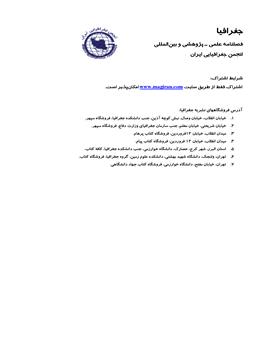Monitor the fountains using images Multi-spectrum satellite of Madis in the southwest of Iran
Subject Areas :
1 -
Keywords: Thumbnails Gold Pictures HYSPLIT Model Remote Sensing ,
Abstract :
The purpose of this study is to monitor dust in the southwest of Iran using satellite data Is a lady In this research, we used the pictures of 2010-2015 years. According to the studies, it has been observed that various models have been presented in previous studies. Then, using the HYSPLIT model, the prediction of the trajectory of dust motion has been addressed. To evaluate the performance of classifying methods, eight material images have been used between 2010-2015. By studying the results of classification of the images of the material using AOD educational data, one of the methods used in previous research of the backup algorithm in the southwestern part of Iran is more suitable than the other method Is. Then, using the HYSPLIT model, the dust trail of the southwestern region of Iran represents the external origin as the main source of this phenomenon in Iran.
1. ایلانلو م. (1391)، نقش اثرات زیست¬محیطی گردوغبار در مناطق خشک و نیمه¬خشک. دومین کنفرانس برنامه¬ریزی و مدیریت محیط¬زیست، تهران، دانشگاه تهران؛
2. اردبیلی ل. (1389)، بررسی فرایندهای موثر در تشدید گردوغبار در سال¬های اخیر ایران. دومین همایش ملی فرسایش بادی، یزد، انجمن علمی مدیریت و کنترل مناطق بیابانی ایران؛
3. اسماعیلی ا. (1385)، پهنه¬بندی مقدماتی مراکز غبار کشور با استفاده از فناوری سنجش از دوری، پایان¬نامه ارشد، دانشگاه صنعتی شریف، دانشکده عمران، گرایش محیط¬زیست؛
4. ایرانمنش ف، عرب خدری م، اکرم م. (1384)، بررسی مناطق برداشت ذرات گردوغبار و ویژگی¬های انتشار آن¬ها در طوفان¬های منطقه سیستان با استفاده از پردازش ماهواره¬ای. پژوهش و سازندگی شماره 67، صص 25-33؛
5. بیدختی ع و همکاران. (1392)، بررسی رویداد طوفان گرد و غبار روز 5 جولای 2009 در منطقه خاورمیانه، دومین همایش ملی مدیریت آلودگی هوا و صدا؛
6. خسروی م. (2010)، بررسی توزیع عمودی گردوغبار ناشی از طوفان در خاورمیانه با استفاده از مدل NAAPS مطالعه موردی: سیستان ایران، مجموع مقالات چهارمین کنگره جغرافی¬دانان جهان اسلام، ص 1-22؛
7. رئیس¬پور، کیوان؛ خسروی، مریم؛ طاووسی، تورج (1389)، تحلیل همدیدی سامانه¬های گردوغبار استان خوزستان، جغرافیا و توسعه شماره20؛
8. شمشیری، سامان؛ جعفری، رسول؛ سلطانی، سمیه؛ رمضانی¬، ناصر (1393)، آشکارسازی و پهنه¬بندی ریزگردهای کرمانشاه با استفاده از تصاویر مادیس، بوم¬شناسی کاربردی، سال سوم، شماره هشتم؛
9. Ginoux, P.A., Prospero, J. M., Gill, T. E., Hsu, C., and Zhao, M. (2012), Global scale attribution of anthropogenic and natural dust sources and their emission rates based on MODIS Deep Blue aerosol products, Rev. Geophys;
10. Goudie, AS, and Middleton, NJ. (2006), Desert Dust in the Global System. Berlin: springer.
11. Graaf, M., Tilstra, L.G., Stammes, P. and Aben,E.A.A. (2009), Satellite observations of theseasonal cycles of absorbing aerosols in Africa related to the monsoon rainfall, 1995 – 2008 Atmos. Environm., 44, 10, 1274-1283;
12. Hao, X., Qu, J. (2007), Sahran dust storm detection using moderate resolutionimaging spectroradiometer thermal infrared bands. Journal of Applied RemoteSensing, Vol. 1;
13. Hao, X., Qu, J. J., Hauss, B., Wang, C. (2007), A high-performance approach forbrightness temperature inversion‖. International Journal of Remote Sensing,Vol. 28, No. 21, 4733-4743;
14. Hastie, T., Tibshirani, R., and Friedman, J.(2009), The Elements ofStatistical Learning Data Mining. Inference, and Prediction., Springer., second edition;
15. Herman, J. R., BhartiaP. K., TorresO. HsuC. SeftorC. And CelarierE. (1997), Globaldistribution of UV-absorbing aerosols from Nimbus 7/TOMS data. J. Geophys. Res., 102(D14),16,911–16, 922;
16. Hickey, B. and Goudi, A. (2003), The use of TOMS and Modis to identify dust storm source areas: Tokar Delta (sudan) and the Seistan Basin (south west asia);
17. Hojatia, S., Khademia, H., Canob, A.F. and Landic, A. (2012), Characteristics of dust deposited along a transect between central Iran and the Zagros Mountains. CATENA, Volume 88, Issue 1, Pages 27–36;
18. Wilkerson, W. D. (1991), Dust and sand forecasting in Iraq and adjoiningcountries. Air weather service T-91/001, p63;
19. You-zhi, F, Kun-xunL, and RongD. (1994), The Causative Factors and Forecasting of the Black Storm in Hexi Corridor. Journal of Meteorology, (12)20: 50.


